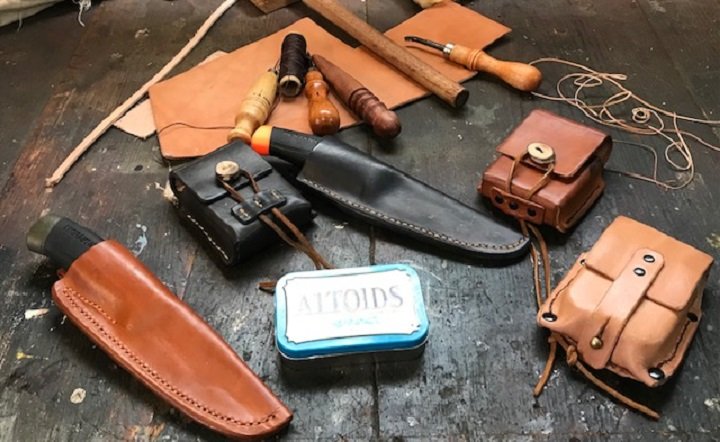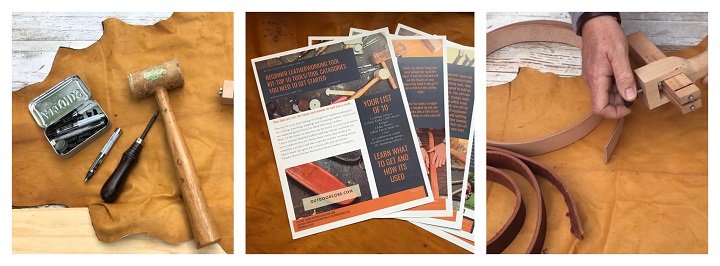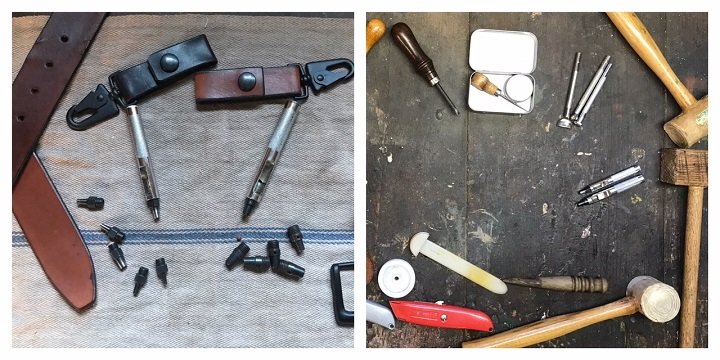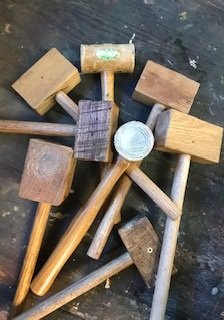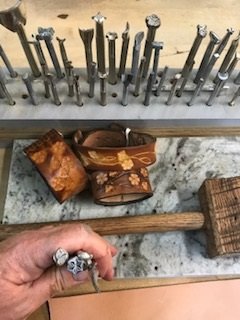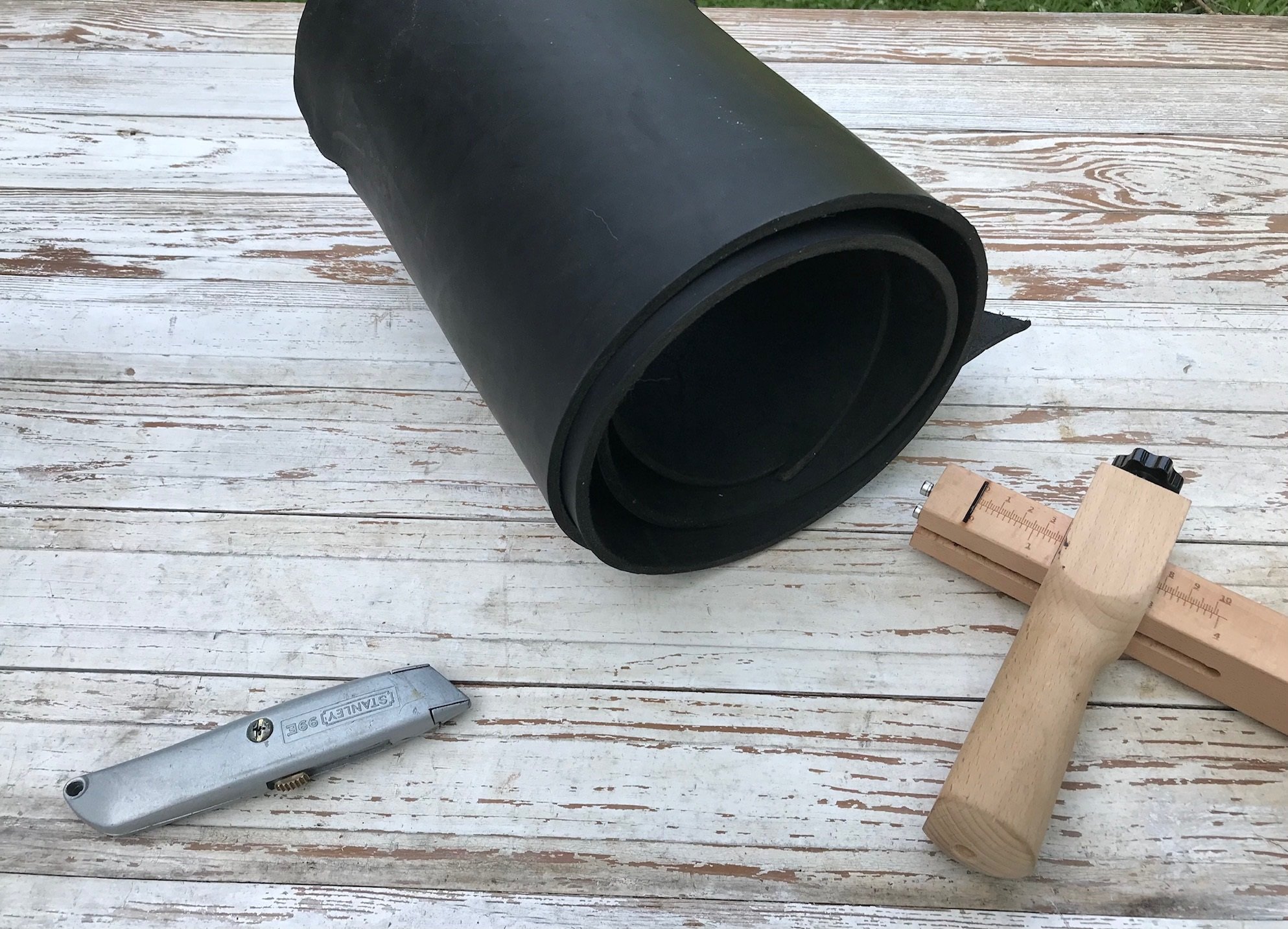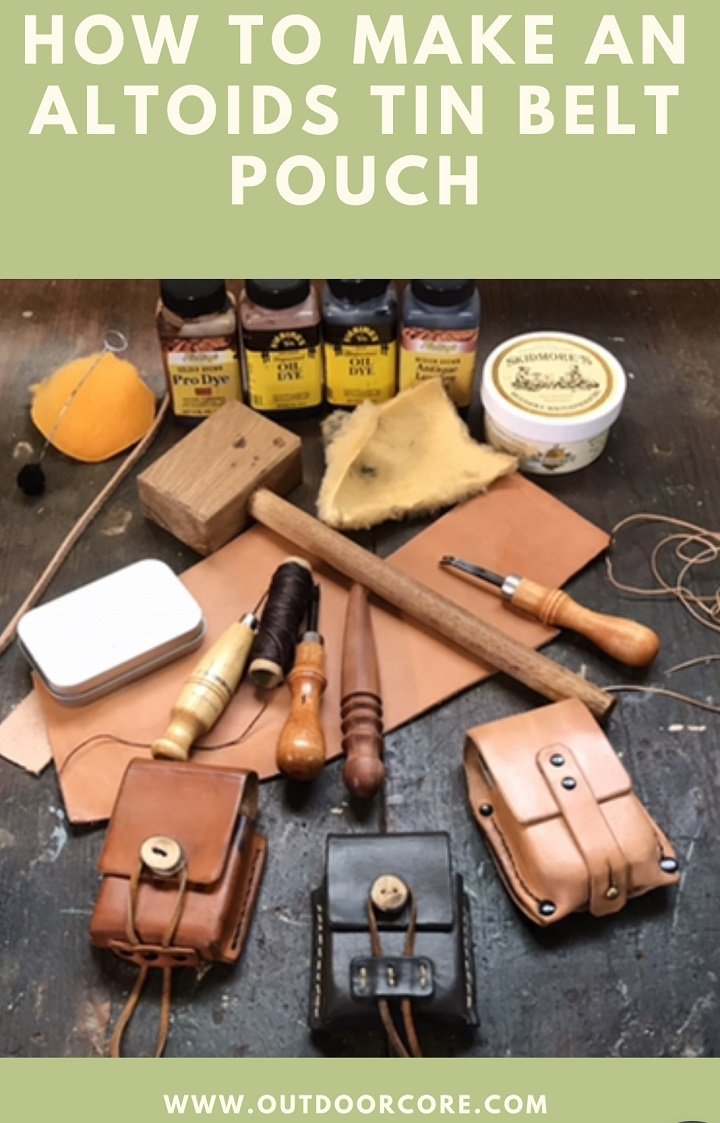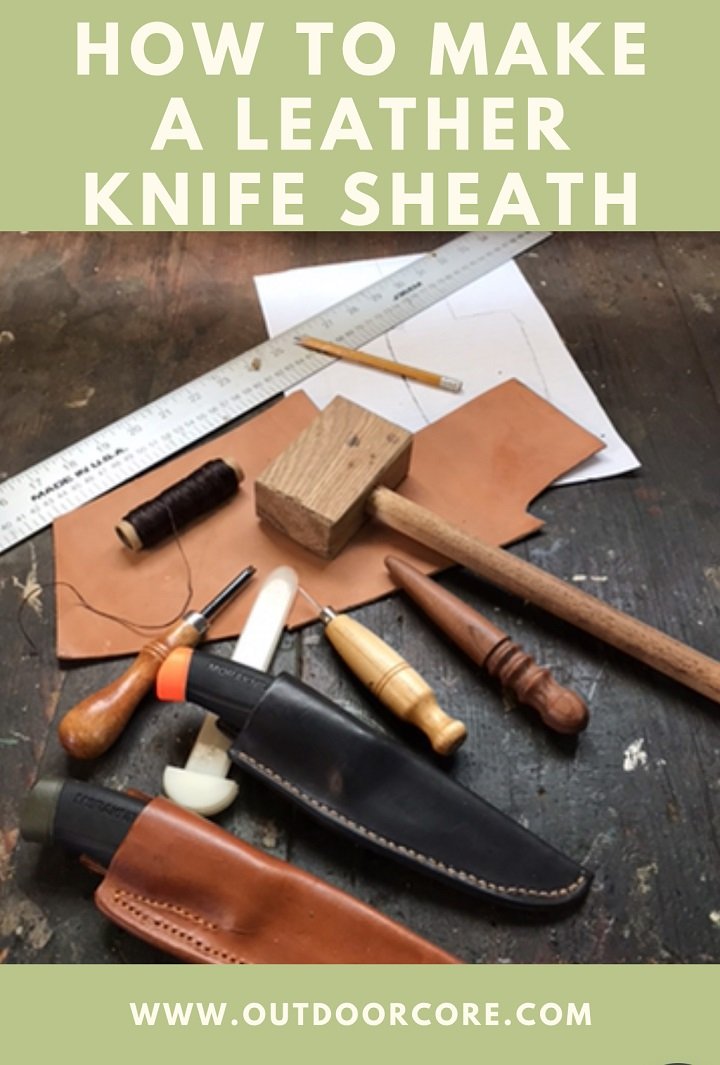BEST BEGINNER LEATHERWORKING KIT (Free Top 10 Tools Resource Guide)
Learn what items you really need in a beginner leatherworking kit. This guide arms you with additional information on the use and safety aspects of beginner leatherworking tools.
Have you wanted to get started in leatherworking but did not know what to get first? This article and my two free instant downloadable buyer’s guides show you how to put together a beginner leatherworking kit on a budget. This will save time and give you the best results on your first project.
ENTER EMAIL BELOW TO RECIEVE AN INSTANT DOWNLOAD TOP 10 TOOLS NEEDED FOR A BEGINNER LEATHERWORKING KIT
I got into leatherwork so I had something constructive to do while our newborn took naps. It turned into a fun and rewarding hobby that I eventually shared, teaching kids and young adults in my community along with that “newborn” as he grew.
I have often scrambled to create a list for students who wanted to get their own tools and wished there was a comprehensive article and free guides I could turn to. Well, here it is. I can show you a fun and safe approach that will start you on your journey with you own beginner leatherworking kit.
WHAT BEGINNER LEATHERWORKING KIT IS BEST FOR YOU? CUTTING AND SHAPING? SEWING? OR BOTH?
The type of projects you do will determine what beginner leatherworking kit or kits are needed. We will explore where your interests lie and what is the best approach for you. We can divide this into two categories, cutting, shaping, stamping, or sewing. Some projects require both. Don’t worry, my first project required all that and the only items I had from a leather store were special needles and thread, the rest were “make do” items I had around the house and kitchen.
If your goal is to make belts, key chains, and coasters those can be accomplished with hole punches, knives and stamps found in my cutting shaping and stamping guide, you can also get the separate sewing guide that covers the basics there as well.
SOME OF TOOLS YOU NEED TO SHAPING LEATHER IS FOUND RIGHT AT HOME, THE HARDWARE OR DISCOUNT STORE
There are many simple tools that belong in a beginner leatherworking kit you may already have or can pick up local. The most important is a safe work surface which can be a two foot by two foot piece of plywood (at least 5/8 or thicker) with an anti-slip mat (found in the kitchen department) and a clamp to keep it from sliding around. This is a great starting point, thick poly cutting boards work as well, protecting the table or bench and your leather working tools.
Fancy leatherworking knives abound but I use a common retractable blade utility knife for most of my cutting. Get in the habit of closing it after use for safety. Thinner bag leather can be a challenge for regular scissors, but inexpensive EMT shears easily cut through it. You can pick those up anywhere first aid is sold and if you have never owned a pair, you will wonder how you did without them.
For punching holes in leather, you are going to need a leather working specific multi set of punches. Snaps, eyelets, rivets all require a very precise hole to work properly. Avoid a rotary punch, they only work well on thin leather. But if you have the hand strength of Thor then go ahead buy one. I use very firm leather and a rotary punch just does not work well. I detail what brands and models I use and what to stay away from in my guide.
I HAVE FOUND ADJUSTABLE HOLE PUNCHES TO BE THE BEST VALUE AND USE OVER THE YEARS
The following items are leatherworking specific tools for finishing edges of thick leather, marking edges and decorative stamps. Slick edges on firm thick leather are the hallmark of great leatherworking, setting you apart from quickly made shoddy goods. At first you can improvise an edge slicker but eventually its one of the thigs you will really want in your beginner leatherworking kit.
ITEMS ESSENTIAL FOR SMOOTH EDGES ON THICK LEATHER, AN EDGING TOOL TO REMOVE THE SQUARED EDGE AND SLICKERS TO SMOOTH IT OUT
The right mallet, stamps to make decorative designs and a stamping surface round out this selection of tools. A mallet needs to be wood, poly or rawhide. Never use a metal hammer with leatherworking tools, it will damage them. This is covered more in depth in the free download Beginner Leatherworking Kit The 10 Tools You Need To Get Started Shaping, Stamping, Cutting
ENTER YOUR EMAIL BELOW FOR AN INSTANT DOWNLOAD RESOURCE GUIDE-BEGINNER LEATHERWORKING KIT-THE AFFORDABLE APPROACH TO THE 10 TOOLS YOU NEED THE MOST
THE BEGINNER LEATHERWORKING KIT FOR SEWING LEATHER
Stitching can be further divided into two possible areas, thin flexible leather for bags or firm thick leather for knife sheaths and pouches that are often molded to fit the items they carry. Some projects like a sporran require both thick and thin leather. For safety the thick leather utilizes awls and even improvised hole drilling methods like I teach in my online Outdoor Core classes.
If you plan on sewing thicker leather gluing and clamping will make life easier and the end product stronger. Small spring loaded claps can be found in multi packs in every hardware store. Amazing Goop brand contact adhesives are what I have used for years, they work well and are available at all discount and hardware stores. Remember to save a few leather scraps to put under claps to avoid imprinting the clamp into the leather.
The right needles are required for safety, heavy leather means you must make a separate hole then follow with blunt needles and the right thread. Thin flexible leather can be stitched directly with sail needles which have a 3 sided tip. Most cheap kits on Amazon do not have the right needles and typically not the right type of awl. None of them address using a pliers or the type that is needed in a beginner leather working kit. The specific items I use are listed out in my instant download guide.
A FEW ITEMS BEYOND BASIC TO MAKE YOUR BEGINNER LEATHERWORKING TOOL KIT YOUR OWN
Overall leatherworking tools can be bought slowly as your interest and project list grows, adding to your beginner leatherworking kit. A side benefit of leatherworking is the mindset and ability to fix or repair not just leather goods but canvas/nylon bags, shoes, and packs. This depends on what you get into but snaps, rivets, eyelets all require specific setting tools that you will find useful for many projects. Don’t worry, most of these setters are inexpensive, cheaper than a fancy coffee drink. You will look like the neighborhood hero when you replace a broken snap on someone’s favorite jacket.
Make more than a few belts and a strap cutter used to cut strips out of leather sides will make sense (save money as well). If many of your projects require stitching a stitching pony becomes a good investment. This simple wooded clamp holds the work firm so you can use both hands to sew.
A STRAP CUTTER IS A MUST HAVE ITEM FOR MAKING BELTS AND STRAPS
Carving is a neat skill to learn, creating wonderful dimensional designs on leather. Although this is easily learned I did not include it in a beginner leatherworking kit. This is more of a walk before you run type of list, just the basics and some people just don’t develop an interest in one skill or another. If you find carving your thing it requires a swivel knife and specialty stamps that bevel and shape designs in the leather. There are many tracing patterns and resources available for carving, don’t feel like you have to reinvent the wheel. I always encouraged students starting out to use a template and guides so they can concentrate on learning the actual carving and shaping skills.
A FEW ITEMS NEEDED FOR SEWING LEATHER
GETTING STARTED
If you are new to leatherworking the best thing to do is pick out a few relatively simple projects and decide what tools you need in your beginner leatherworking kit to accomplish them. I have included online sources for purchasing leather and tools that you cannot find in local stores.
Using precut blanks for keychains and bracelets is a great way to test the water, you avoid cutting and focus more on getting designs right, edges polished, and the finish applied correctly. These are good projects to work along side your child or young adult with. They will be able to walk away with a finished project in a few hours which is a huge confidence builder.
PRECUT BLANKS ARE A GREAT WAY TO GET STARTED AND GET KIDS INTERESTED IN BEGINNER LEATHERWORKING
If all this sounds good and you are ready to put your beginner leatherworking kit to use I have another way to help. I have two online courses for beginners that cover every conceivable step of a project from start to finish. This includes leather selection, saddle stitching techniques and tricks, wet molding leather, using an edger, selecting the right finish, and applying it.
These courses are set up like private lessons broken into small easy to digest segments. The How to Make A Leather Altiod’s Tin Belt Pouch would be the best to start with and contains a full size pattern as well, huge time saver.
Download the free guides and check out the courses on the OutdoorCore Online Learning Platform. You will find the guides not only cover model numbers and sources but are loaded with safety tips.
Check it out and let me know if you have any questions. I wish you the best with your new hobby and hope to see you do well with your beginner leatherworking kit.
ENTER YOUR EMAIL BELOW FOR AN INSTANT DOWNLOAD RESOURCE GUIDE-BEGINNER LEATHERWORKING KIT-THE AFFORDABLE APPROACH TO THE 10 TOOLS YOU NEED THE MOST

